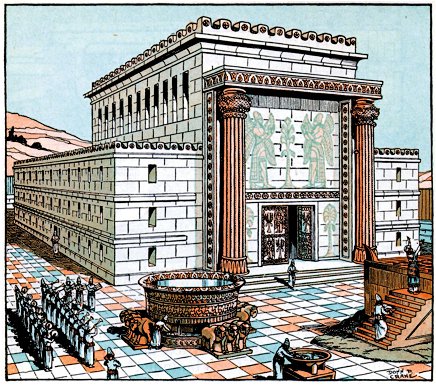
WHY ISRAEL?
The Middle East is considered by many to be the heart of some of the most important religions and cultures in the world: Solomon’s Temple of the Hebrews is now the site of the Dome of the Rock Mosque, Christians make pilgrimages to the Holy Land, and young people of Jewish tradition visit Israel through the Taglit-Birthright initiative. Biblical traditions state that houses of prayer were to be open for all nations: “for mine house shall be called an house of prayer for all people” (Isa. 56:7). Can the religious and cultural traditions of the great faiths find inspiration in the ancient Temple of Solomon?
JOINT-VENTURE BETWEEN TWO NATIONS

The Cedars of Lebanon, famous for fragrance, are also legendary for their strength for building. But in ancient times, however, these trees were the arbors of the Phoenicians. It was their King, Hiram of Tyre, (still the 4th largest city in what is now Lebanon) who entered into a cooperative agreement with the Hebrews. In what may be one of the first multi-national ventures in history, Hiram’s Phoenicians supplied cedar and fir building materials. In exchange, Solomon’s Hebrews supplied food, “twenty thousand measures of wheat.” In an ingenious delivery system, timber was floated down the river from Lebanon to a pick-up location in Israel where food supplies awaited. The two countries cooperated in other ways; for example: jobs training
BI-NATIONAL HUMAN RESOURCE DEVELOPMENT
The Phoenicians possessed architecture and construction skills and familiarity with building materials. They were expert engineers, and had already built a palace for King David, Solomon’s father. But when the temple was planned, vast numbers of laborers were needed. The Hebrews supplied the workforce, overseen by master builders from Tyre in a rotation system in which 30,000 workers were divided into three groups. Each group worked one month on/two months off. Therefore, as one work unit returned, another was ready; workers were always rested and fresh.

Another feature of the rotation system was maintenance of the existing economy while developing a new one. Because each worker was away only one month at a time, families at home could maintain farm or business for a few weeks with little difficulty until the workers returned. Therefore, the local Hebrew economy continued uninterrupted, even as laborers were recruited from its population. As a bonus, because of the Phoenician/Hebrew workforce exchange, Israel acquired engineering and construction knowledge.
Perhaps because of their exchange relationship, there was no recorded discord between the two countries in the shared region that today might benefit from increased cooperation.
PRE-FAB
The Temple of Solomon may be one of the first known instances of prefabrication. In 1 Kings 6:7 it is stated, “And the house, when it was in building, was built of stone made ready before it was brought thither: so that there was neither hammer nor axe nor any tool of iron heard in the house, while it was in building.” The intent was to avoid disturbing the sacred place with the noise of hammering. Sections of the temple were prefabricated and installed on-site. Interestingly, Gustav Eiffel used a similar approach to building his iconic tower in Paris. The Eiffel Tower’s iron framework was crafted in a nearby factory, and then assembled and welded onsite by four-person teams who trained together, working in a carefully orchestrated assembly process. The French project, finished not only early, but on budget, had construction fatalities (although one gent died at a party while on weekend leave).
OPEN TO ALL
Solomon’s Temple was a “house of prayer for all people,” (Isa. 56:7) There are few instances of stated inclusion in the history of macro projects. Another is the Suez Canal whose “tariffs of dues for passage…shall be always equal for all nations.“ (Article VI, Firman of Concession, November 30 1854.) Did the Hebrews establish a tradition that can inspire the future?
ARK OF THE COVENANT

Solomon’s Temple is unique among ancient temples in that it did not have idols. This is significant because in that era, it was common practice to house idols in grand structures so spirits of the gods could enter and be present. The Phoenicians built temples. Egyptians too; in fact, Moses was educated in Egypt. But within Solomon’s Temple, in the Holy of Holies, instead of an idol, the Ark held the Covenant. For the first time in recorded history, the law, not an idol, was enshrined.
Document of Authorization
Below is an excerpt from the King James Bible regarding construction of the Temple.
And, behold, I purpose to build an house unto the name of the Lord my God, as the Lord spake unto David my father, saying, Thy son, whom I will set upon thy throne in thy room, he shall build an house unto my name.
Now therefore command thou that they hew me cedar trees out of Lebanon; and my servants shall be with thy servants; and unto thee will I give hire for they servants according to all that thou shalt appoint; for thou knowest that there is not among us any that can skill to hew timber like unto the Sidonians…
My servants shall bring them down from Levanon unto the sea: and I will convey them by sea in floats unto the place that shalt appoint me, and will cause them to be discharged there, and thou shalt receive them: and thou shalt accomplish my desire, in giving food for my household.
So Hiram gave Solomon cedar trees and fir trees according to all his desire
And Solomon gave Hiram twenty thousand measures of wheat for food to his household, and twenty measures of pure oil thus gave Solomon to Hiram year by year.
And king Solomon raised a levy out of all Israel: the levy was thirty thousand men.
And he sent them to Lebanon ten thousand a month by courses; a month they were in Lebanon, and two months at home.
-From the Bible, King James version, 1 Kings, chapter 5.
VOICES OF THE FUTURE: Discussion and Implications
Regions or Nations?: Solomon’s Temple suggests possibilities that emerge when resources are seen as regional, not national. For example, Phoenicians and Israelites worked together cooperatively to build the temple: expertise in construction (Phoenicians) was exchanged for know-how in agriculture (Israelites). Cedars and fir trees from one nation were the building materials for another. Workers from two different societies cross-trained, spreading knowledge to the entire region.
How can we apply the model of exchange and cooperation seen in Solomon’s Temple to other regions of the world? Are there possibilities for NAFTA in which Mexico, the United States, and Canada can cooperate? What about the current Middle East? How about the Eurozone?
Rule of Law: Many of us have heard the phrase “Ark of the Covenant” yet perhaps have not reflected on its radical innovation. Moses, who was raised in Egypt, was familiar with the Egyptian tradition of building sacred tabernacles or “arks” in which were placed idols. Keeping with that custom, Solomon’s Temple also had an ark. But within was placed the Law. This was such a remarkable turn in the history of civilization that is must be noted with great interest. How does our society treat the “Rule of Law?”
RESOURCES
To read the complete chapter, members of the University of Massachusetts Boston may access the e-book through Healey Library Catalog and ABC-CLIO here. Alternatively the volumes can be accessed at WorldCat, or at Amazon for purchase. Further resources are available onsite at the University of Massachusetts Boston, Healey Library, including some of the following:
Building the World Collection Finding Aid
“On the Location of the First and Second Temples in Jerusalem,” by Lambert Dolphin and Michael Kollen, http://www.templemount.org/theories.html
“Phoenician Design of King Solomon’s Temple,” by David Skinner, http://phoenicia.org/temple.html
“Google helps put Dead Sea Scrolls online,” BBC News, Technology, 26 September 2011. Five scrolls, including the Temple Scroll, have been imaged by Ardon Bar-Hama, photographer of antiquities, using ultraviolet-protected flash tubes to light the scrolls for 1/4000th of a second. The scrolls were found in 11 caves along the Dead Sea, east of Jerusalem, between 1947-1956. In a cooperative project with the Israel Museum, Google helped digitize the scrolls which can now be viewed online: http://dss.collections.imj.org.il/temple

Building the World Blog by Kathleen Lusk Brooke and Zoe G. Quinn is licensed under a Creative Commons Attribution-NonCommercial-NoDerivs 3.0 Unported License.

The Original 1st Temple of King Solomon is Actually Located as Being Castelo de Ourem Santarem Portugal. I have The Original Acacia wood Made map and the Key of King Solomon! It Contains A Architectural design carved figure of The 1st Temple in it. This concern 960bc before Portugal phoenician to hebrew history.